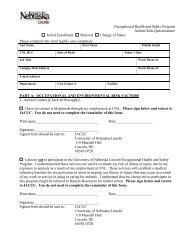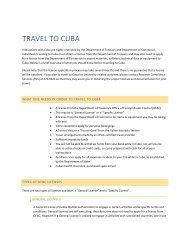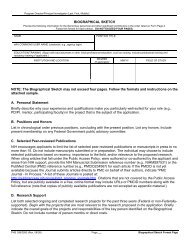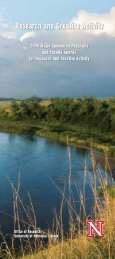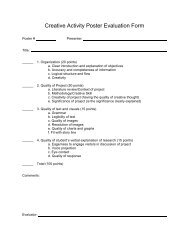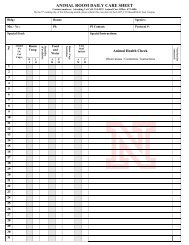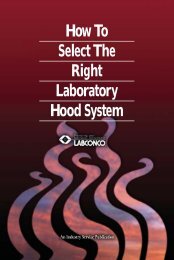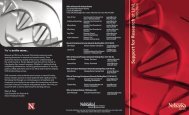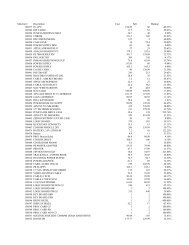Reporting Unexpected Adverse Events (AEs)
Reporting Unexpected Adverse Events (AEs)
Reporting Unexpected Adverse Events (AEs)
Create successful ePaper yourself
Turn your PDF publications into a flip-book with our unique Google optimized e-Paper software.
University of Nebraska Lincoln - Institutional Animal Care Program<br />
Policy on the <strong>Reporting</strong> of <strong>Unexpected</strong> <strong>Adverse</strong> <strong>Events</strong><br />
During Animal Research, Teaching, or Extension Activities<br />
What is an unexpected adverse event (AE)?<br />
An AE is any occurrence that was not described in the approved AUF or subsequent<br />
modifications, and which has an impact on animal welfare.<br />
Why should <strong>AEs</strong> be reported?<br />
<strong>Reporting</strong> assists the IACUC in their federal requirement to monitor animal activities. It<br />
encourages PIs, animal care staff, and the attending veterinarian to investigate the cause<br />
of events and ways to prevent reoccurrence. Reports of <strong>AEs</strong> provide documentation of<br />
animals experiencing unexpected pain or distress for proper categorization on the<br />
mandatory Annual Report to the USDA.<br />
Who should report <strong>AEs</strong>?<br />
PIs and animal facility managers should report to the IACP as soon as they become aware<br />
of an event that may impact animal welfare. It is not necessary for both PI and manager<br />
to report the same event if they are aware that a report has already been made, but both<br />
are responsible for ensuring accurate and timely communication with IACP.<br />
What qualifies as an AE?<br />
When in doubt, report it. <strong>Events</strong> with mild impact may need investigation if they affect<br />
significant numbers of animals, will have an impact on other animals or activities, or<br />
reflect a situation that could be more severe in the future. This allows IACP to act<br />
proactively to prevent future problems. Even pain or distress that is appropriately and<br />
quickly relieved with analgesics may change the reporting category for an animal, so PIs<br />
should not fall to the misconception that animals must die to be reported.<br />
How do I avoid making many reports for things that normally happen?<br />
A report is not required if the IACUC is aware that an adverse event may occur and the<br />
event has happened as was expected and approved. When your experience causes you to<br />
expect certain complications in your research, indicate and explain the possible adverse<br />
events in your Animal Use Form. For example, list potential mortalities from induced<br />
infection, trapping, or surgery.<br />
What are examples of events that must be reported?<br />
• Deaths of animals not described in AUF<br />
e.g. 2 of 10 cattle die during shipping, pig found dead the day after surgery.<br />
• Study-related complications not described in the AUF<br />
e.g. dog has an allergic reaction to a treatment, pig anesthetic doesn’t work<br />
adequately, rabbits develop infection following surgery
• More deaths or complications than described in AUF<br />
e.g. 10% of cats die following surgery when a 5% fatality rate was expected<br />
and justified in the AUF, cattle appear to be in more pain or distress from a<br />
procedure than expected<br />
• Facility or equipment failure has or may have an impact on animal welfare<br />
e.g. loss of electrical power temporarily alters HVAC function, cow is injured<br />
in a malfunctioning restraint chute<br />
• Poor facility, husbandry, or care has or may have an impact on animal welfare<br />
e.g. pig burned by heat lamp, birds develop sore feet caused by cage flooring<br />
What are examples of events that do not need to be reported?<br />
• Injury or illness unrelated to study procedures that are being treated by the<br />
attending veterinarian or a contract veterinarian.<br />
e.g. a dog is diagnosed with coccidia, a calf is treated for bloat<br />
• Deaths of animals as expected and approved in the AUF.<br />
e.g. up to 5% poultry mortality was expected from Newcastle’s and 3% died<br />
What information needs to be reported?<br />
The report should include the nature of the event, how the event and animal welfare were<br />
monitored or addressed, the actual or potential impact of the event on animal welfare, the<br />
actual or potential impact of the event on the study outcomes, and what immediate and<br />
long-term steps are being taken or considered to prevent future reoccurrence of the event.






